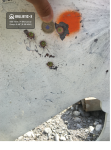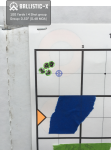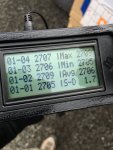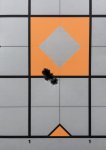That was my concern with them i couldn't wrap my head around the tumble thing so im waiting for someone to try them more before i jump on them. Im also leaving hornady and softer bullets. Keeps up up dated on results
What would you like explained about the tumbling ?
Why it happens?
Rifle bullets are a spin stabilized object.
There are 3 types of stabilization that we're likely all familiar with.
1) Spin stabilized, think bullets
2) Fin stabilized, think arrows and model rockets
3) Hybrid of 1 & 2 that is actively controlled. Think things like the Apollo V rocket and the space shuttle.
In movement through a fluid body, like air, the motion of the projectile is heavily affected by the density of the fluid it is moving through.
In the air we're all familiar, or can at least conceptualize the idea of something tumbling due to instability. The American football is a perfect example. When it's thrown poorly it quickly turns into a tumbling object that has an erratic trajectory.
When it's spun properly it can be highly predictable. Think of the forward pass or even a well kicked punt. The rotation of the punt stabilizes the football and guys who do it for a living can kick a pretty darn predictable trajectory.
Also, on a long bomb it's not uncommon to see a football start out as what appears to be a perfect spiral but over 50, 60, 75 yards the football starts to wobble a little, then quickly turns into an exaggerated wobble which tumbles and falls out of the air rapidly.
That is an example of something going unstable due to being knocked out of stability. The stitches on the football or just a slightly off-perfect launch during the throw can cause it. Likewise if we have a beautifully spinning top on a table and we touch it the top wobbles and can go unstable and crash quickly. Another example is the baseball. A fastball flies straight due to the spin on it, curve balls "curve" due to the spin, and knuckle balls are erratic because they have (almost) no spin on them. They move all over the place unpredictably.
Keep both of these analogies in your mind for what's coming.
We see this with rifle bullets too, especially the "long for caliber" designs that are 5, 6, 7 calibers long. They start out fine and shoot decent groups at short range, even medium range. But then when a shooter makes the jump to long range, say like a jump from 300 to 800 yards, the bullets appear to vanish and we can't see them. If a spotter watches the trace it appears to be clean for a bit, then explodes into a violent storm of trace and just as quickly disappears. The bullet was marginally stable or unstable on the slow arm of the epicyclic motion equality and over time it destabilized. The explosion of trace is the supersonic bullet yawing and pitching drastically, creating shockwaves that change the air's local refraction index and then rob a huge amount of energy from the bullet to make this happen. It slows down, gets below critical velocity and stops making those visible shock fronts.
So, this probably makes reasonable sense, but then what about hitting an animal?
Let's remind ourselves about the density of the medium. At high (density) altitudes where the air is less dense the bullets may fly just fine. I've seen 198's fly from a 10 twist during summer months in western Montana when the DA was over 6600ft. However, where I live down near sea level they need a 9.5 in the summer and in cooler months they need a 9 here. Where SPAK lives in Alaska, they might even need something faster than that during the winter time.
The more dense, the more twist rate required.
So let's think about hitting that animal now.
The animal is a much denser fluid, something like 400x or more difference in change. Animals are mostly water and they have all kinds of squishy material in them along with some very hard, dense items (bones). When we take a bullet that's flying just fine through the air and hit an animal with it there is an immediate change in the density of the material that bullet is going through. This is an abrupt discontinuity in the flight regime and it's also going to destabilize the bullet based on how it hits too, just like throwing a football and over time it becomes less stable and begins to wobble.
Well, now we have an object that went from a highly stable environment and we hit it with a massive change in medium density as well as a massive destabilizing effect of hitting something. Just like the stable top that we bump on the table.
Now that bullet is unstable and it immediately beings to yaw and pitch due to both the excitation (bump) of hitting the animal and the drastic change in what fluid it was moving through. This causes catastrophic tumbling to the flight path.
Next question, is that bad?
Well, let's back up to the comments I made about watching trace on a marginally stable bullet. As the bullet goes unstable and begins to tumble we see that huge explosion of trace. Those shock fronts that are shedding all over the place from ever edge, corner, point, etc off the bullet that is now presented sideways to the air. The same thing happens in the body of the animal being shot. Those shockfronts are still generated and they still move through the medium (the muscle tissues) and cause catastrophic damage.
Normally the limitations of the bullet have a tempering effect on it. Jacketed bullets break up as they tumble. Jackets separate from the core, cores are lead and they spew into tiny pieces and those tiny pieces become like shooting birdshot into a cinderblock. At 2 feet they are devastating. At 25 feet they do some damage, scuff up the outside but don't penetrate far. But at 25 meters they don't do much more than take the paint off the cinders.
That same effect happens when a jacketed bullet breaks up inside an animal only on a micro scale that is much shorter distance due to the much higher material density. What takes 25 meters to happen in air now happens over the span of mere centimeters.
Therefore, the optimal plan is to have a bullet that can withstand the immense structural forces of hitting flesh, staying together to continue penetration deep into the body and shedding those high energy shockwaves out into the muscles and major organs.
Solids stay together as a matter of their construction. Check.
Expand some to open the wound channel. Check.
Penetrate deep on a big animal. Check.
So we are thinking solids are a good choice, how do we get the best performance from a solid that we can?
It's about arriving with the most kinetic energy as possible. The bullet isn't going to break up but it needs to expand and it will tumble through the cavity. Physics dictates that.
So the designer needs to be able to generate a bullet with the highest possible BC for the given weight and specified barrel twist rate available in order to maximize the potential on game.
The Cayuga solids have unmatched BC's for their weight, even in the hunting bullets. Especially in hunting bullets these things are better than almost all of the match bullets for BC and they're lighter meaning they start out faster, bleed off less energy during flight and arrive on target with more energy and momentum to impart to the target animal.
I maintain that there is not a single bullet for every shot and every animal and every situation. We know that these things clobber game when the person puts them anywhere above the diaphram and into high value zones on an animal. They are still going to expand and tumble if someone liver or gut shoots the animal but like any bullet out there it's not likely to be an immediately mortal wound. For some of the questions I get from people it sounds like they want a guarantee that if they shoot the animal in the hoof the thing will fall down dead but there's no such bullet. Ultimately we do have to be capable hunters and make the shots, there are no magic bullets, but from the performance of BC, expansion, structural integrity for penetraion and tumbling off hydrostatic shock energy these are probably as close as it gets for big, heavy game.





